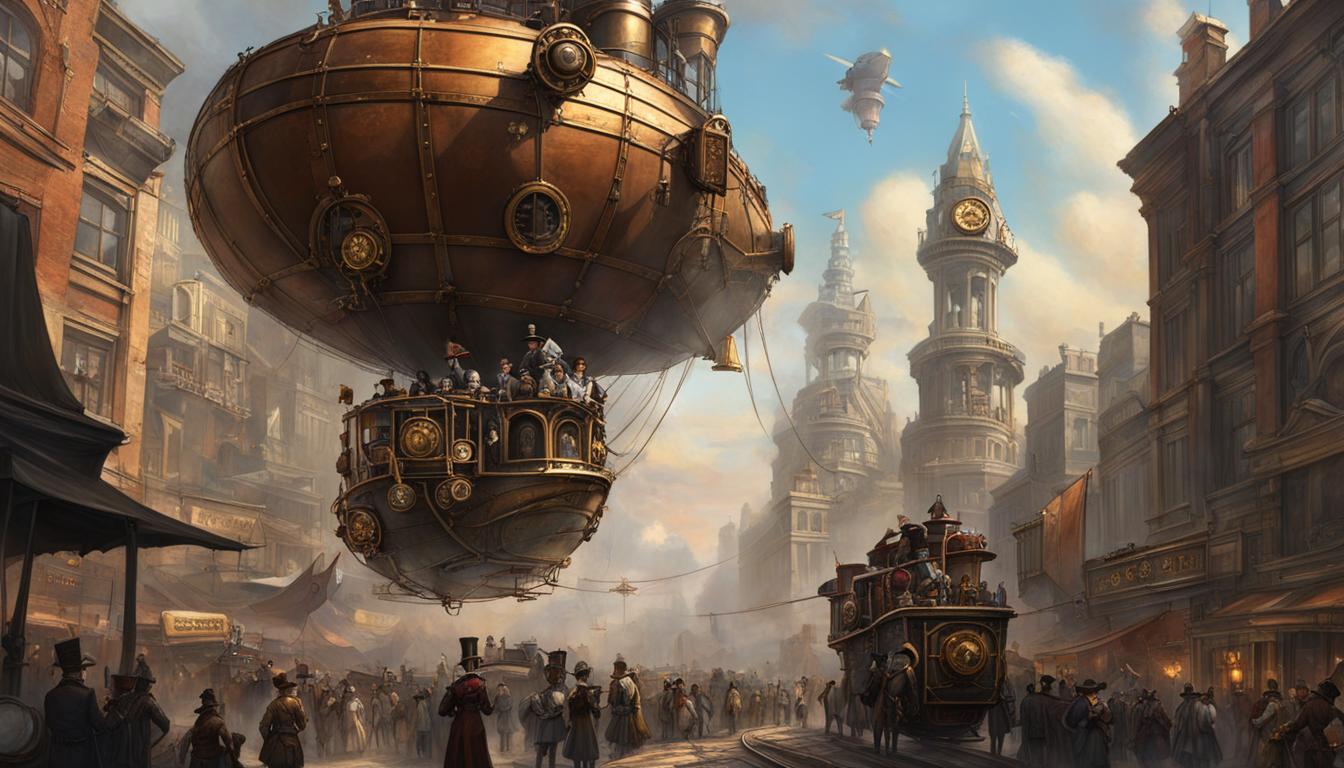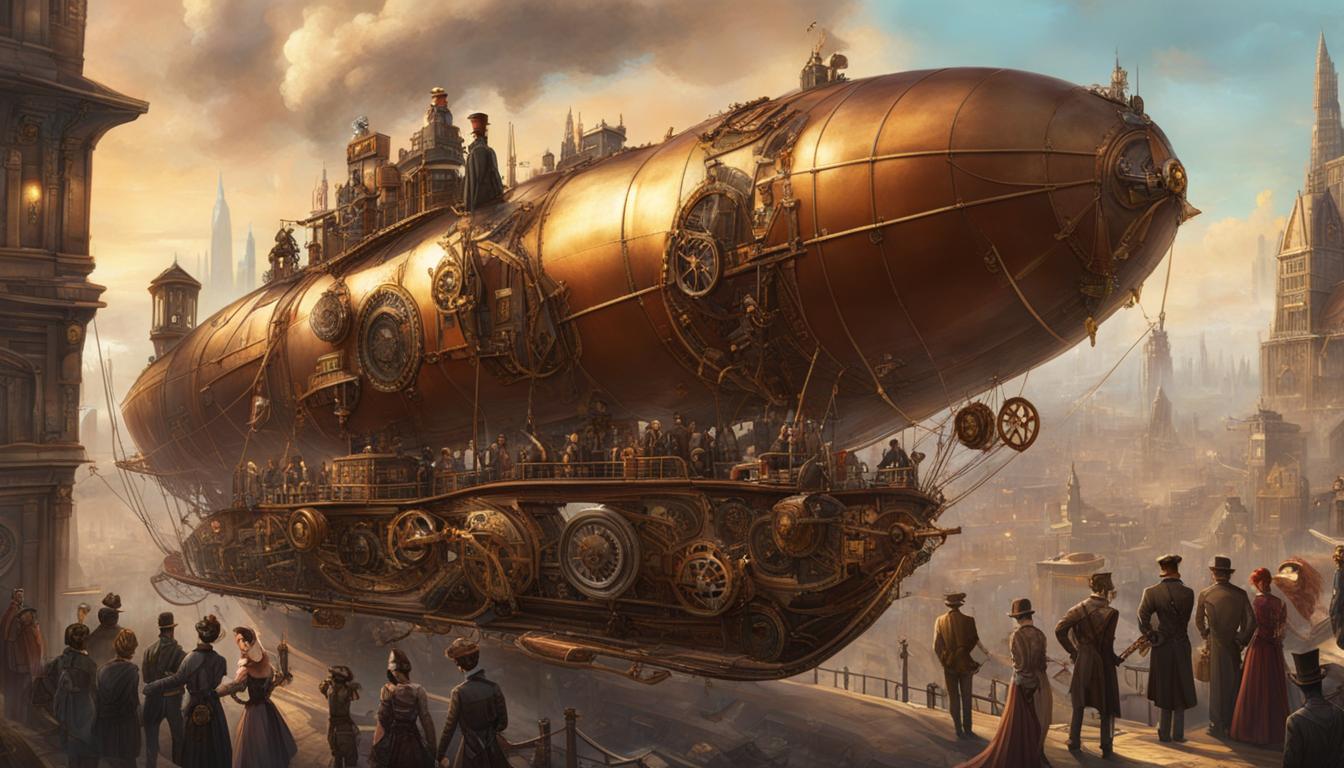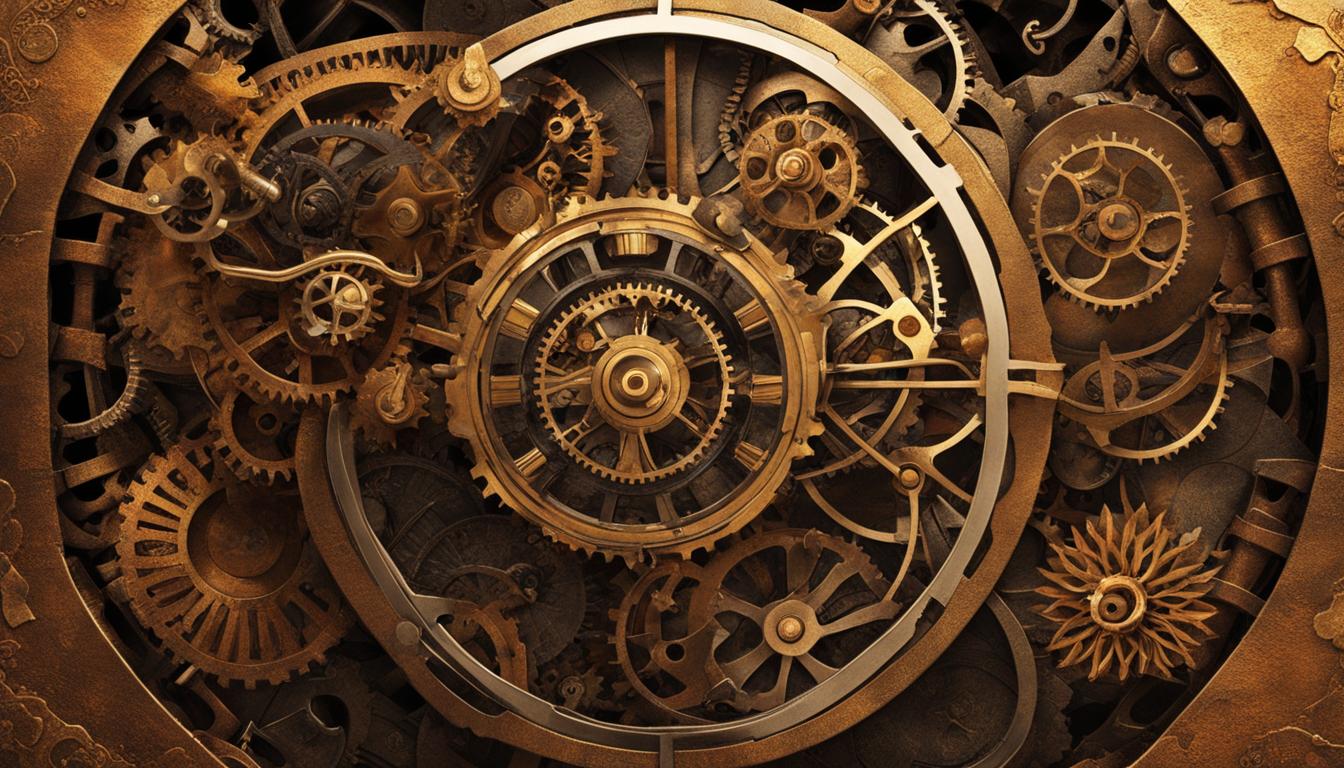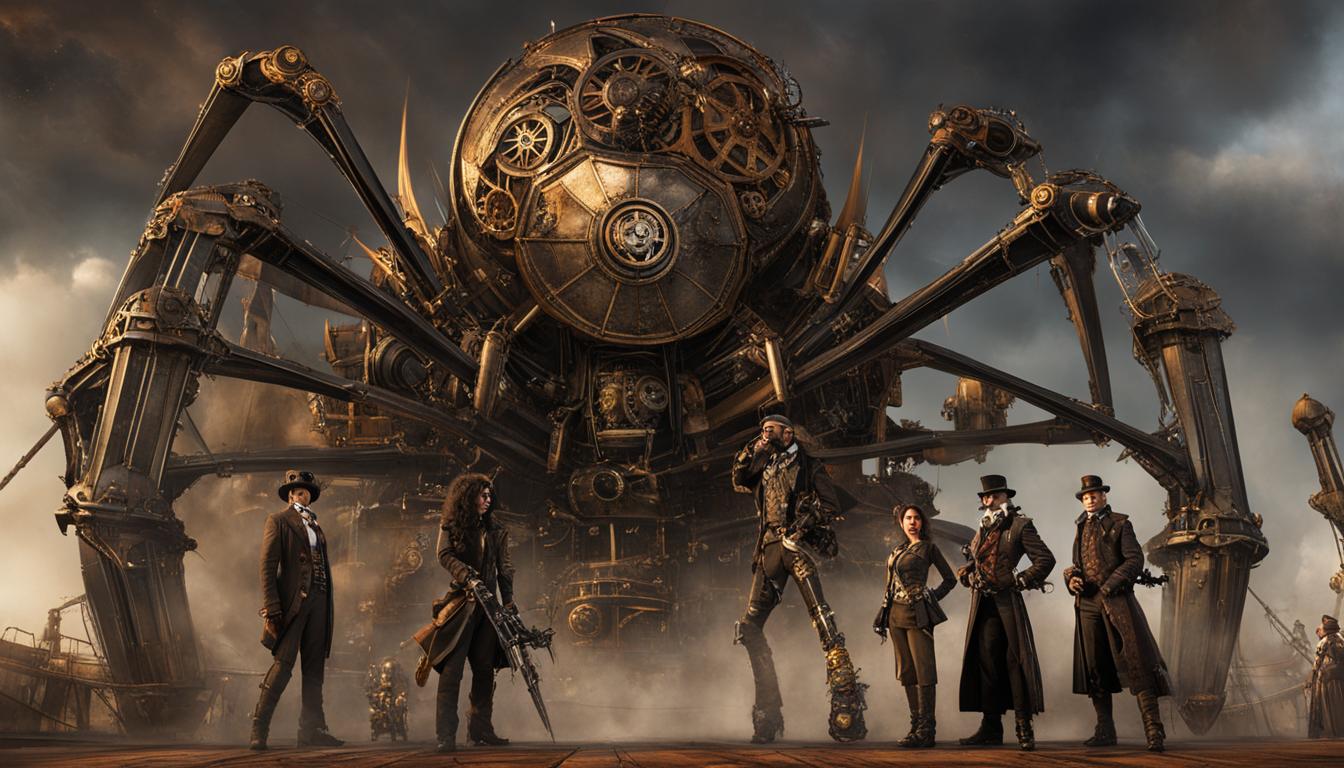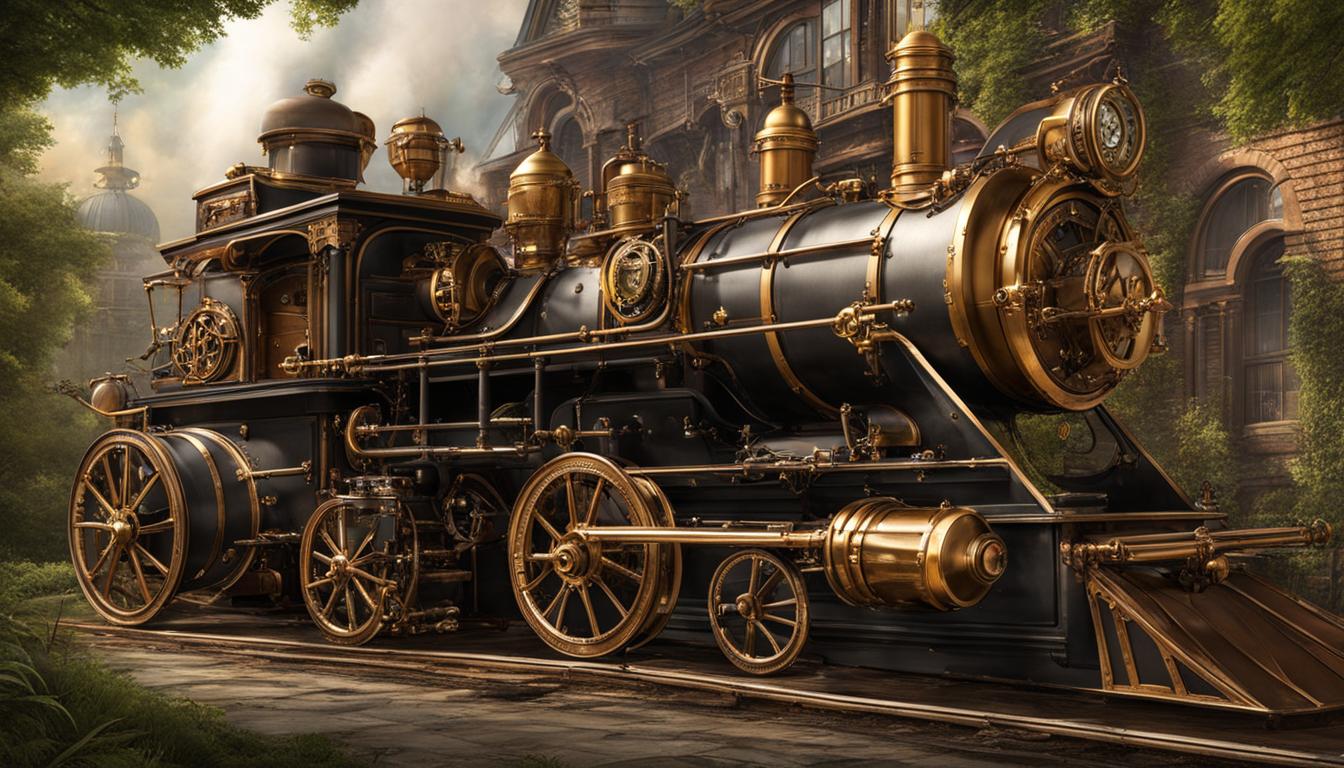Steampunk, the captivating subgenre of science fiction, offers a unique twist on the representation of famous historical figures. With its retrofuturistic technology and Victorian-era aesthetics, steampunk breathes new life into iconic leaders, authors, and social reformers who have left an indelible mark on history. From envisioning Frederick Douglass as a valiant freedom fighter to reimagining David Kalākaua as a Hawaiian adventurer, steampunk seamlessly combines history and imagination.
In the world of steampunk, these historical figures are not mere inspirations, but vibrant characters who engage in daring adventures and shape alternative societies. They embody the themes of resistance, adventure, and social change that define the steampunk genre, captivating readers and viewers with their intriguing stories. Whether it’s the portrayal of Mary Shelley as the mother of steampunk literature or the incorporation of Edgar Allan Poe’s gothic tale into the heart of this subgenre, steampunk transforms these figures into captivating protagonists.
Key Takeaways:
- Steampunk offers a fresh take on famous historical personalities by merging history and imagination.
- Historical figures in steampunk become vibrant characters who engage in daring adventures and shape alternative societies.
- These figures embody the themes of resistance, adventure, and social change that define the steampunk genre.
- Mary Shelley and Edgar Allan Poe are among the historical figures whose stories are reimagined in steampunk worlds.
- Through alternative scenarios, steampunk invites readers and viewers to explore the impact of these figures on society.
Frederick Douglass – A Voice for Freedom in Steampunk Tales
Steampunk literature often takes historical figures and gives them a new life in alternative settings. One such figure is Frederick Douglass, a prominent 19th-century social reformer, abolitionist, writer, and statesman. In the realm of steampunk, Douglass is portrayed as a courageous hero fighting for freedom and equality.
In various steampunk novels, Douglass’s story is reimagined in a steampunk setting, showcasing his bravery and advocacy for women’s suffrage. Alternate history works like “Fire on the Mountain” and “How Few Remain” highlight his role in shaping a steampunk world where resistance and social change are at the forefront.
By reimagining Frederick Douglass as a steampunk character, authors and artists pay tribute to his contributions to society while adding a new layer of adventure and excitement to their works. Through these portrayals, Douglass becomes an emblem of resistance, embodying steampunk’s themes and inspiring readers to question the status quo.
| Steampunk Novel | Description |
|---|---|
| “Fire on the Mountain” | A thrilling alternate history where Douglass leads a rebellion against oppressive forces in a steampunk-inspired America. |
| “How Few Remain” | Set in a steampunk version of the Civil War era, Douglass plays a vital role in shaping the outcome of the conflict through his leadership and determination. |
These portrayals of Frederick Douglass in steampunk serve as a reminder of his lasting impact on history and his continued relevance in contemporary storytelling. By placing him in a steampunk setting, creators not only honor his legacy but also bring his ideals of freedom and equality to new audiences.
David Kalākaua – The Steampunk King of Hawaii
David Kalākaua, the last king of the Kingdom of Hawaii, had a unique connection to the world of steampunk. As a monarch who sought to modernize his kingdom, Kalākaua’s interest in advanced technology and his world tour in the late 19th century make him a fascinating figure to reimagine in a steampunk context.
In many steampunk representations, Kalākaua is depicted as an adventurer, combining the rich cultural traditions of Hawaii with the aesthetic and technological wonders of the Victorian era. He becomes a symbol of exploration and innovation, embodying the spirit of steampunk’s fascination with both the past and the future.
One notable aspect of Kalākaua’s connection to steampunk is his association with Thomas Edison, the renowned inventor. Edison visited Hawaii during Kalākaua’s reign and gifted him several technological marvels, such as phonographs and a telephone system. In a steampunk setting, this connection with Edison and Kalākaua’s efforts to modernize Iolani Palace can be explored in exciting and imaginative ways.
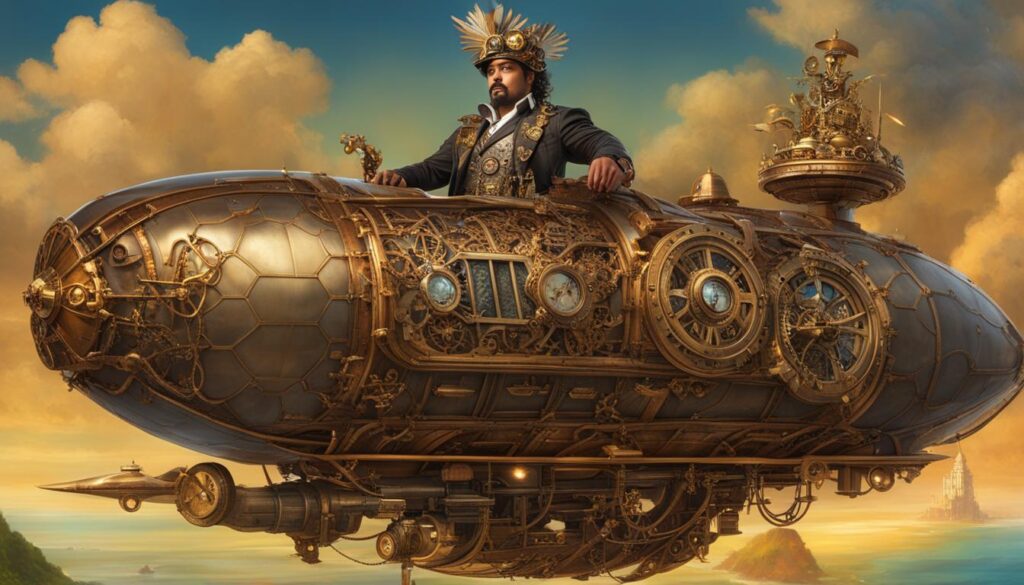
Sitting Bull – A Native American Hero in Steampunk Tales
Sitting Bull, a revered Hunkpapa Lakota leader, has found his place in the captivating world of steampunk. Known for his role in Native American resistance against U.S. government policies, Sitting Bull is now portrayed as a powerful symbol of strength and defiance in steampunk narratives. In these imaginative tales, Sitting Bull often forms alliances with iconic figures like Annie Oakley and Buffalo Bill, becoming an embodiment of indigenous resilience in the face of adversity.
Steampunk offers a unique platform for Native American representation, showcasing the rich history and enduring spirit of indigenous cultures. By weaving Sitting Bull’s story into the fabric of steampunk, creators highlight the importance of honoring Native American heritage and challenging stereotypes. The genre provides a space where historical figures like Sitting Bull can reclaim their narratives and inspire readers and viewers with their resilience and wisdom.
“In steampunk, Sitting Bull becomes a symbol of strength, determination, and the fight against injustice,” says renowned steampunk author and enthusiast, Jane Summers. “His inclusion in steampunk narratives allows us to reimagine history and celebrate the contributions of indigenous people in shaping our world.”
The Steampunk Legacy of Sitting Bull
Sitting Bull’s portrayal in steampunk goes beyond mere historical accuracy. He represents a bridge between the past and the future, blending the traditional and the technological. His inclusion in steampunk stories allows for the exploration of themes such as cultural preservation, resistance, and the clash between traditional values and emerging technologies.
Sitting Bull’s presence in the steampunk genre not only sheds light on Native American history but also invites us to reflect on the ongoing struggles for justice and equality in contemporary society. Through his portrayal, steampunk reminds us of the resilience and power of indigenous peoples and encourages us to challenge the narratives that have marginalized their voices for far too long.
| Steampunk Portrayals of Sitting Bull | Key Features |
|---|---|
| “The Iron Horse Chronicles” by Robert Lee Murphy | An alternate history tale that features Sitting Bull as a prominent character fighting against colonization and the exploitation of indigenous lands. |
| “The Steampunk Confederation” by Shawnee Small | Sitting Bull is depicted as a member of a secret society of Native American inventors who use their knowledge of steam-powered technology to challenge oppressive forces. |
| “Empire of Steam and Smoke” by Dakota Chase | In this steampunk adventure, Sitting Bull leads an alliance of Native American tribes against a corrupt industrial empire, showcasing the strength of indigenous cultures in resisting oppression. |
These examples highlight how Sitting Bull’s story continues to inspire and resonate within the steampunk genre. By incorporating his legacy into their works, authors and creators pay homage to the profound impact of Native American leaders and foster a greater understanding and appreciation for their contributions.
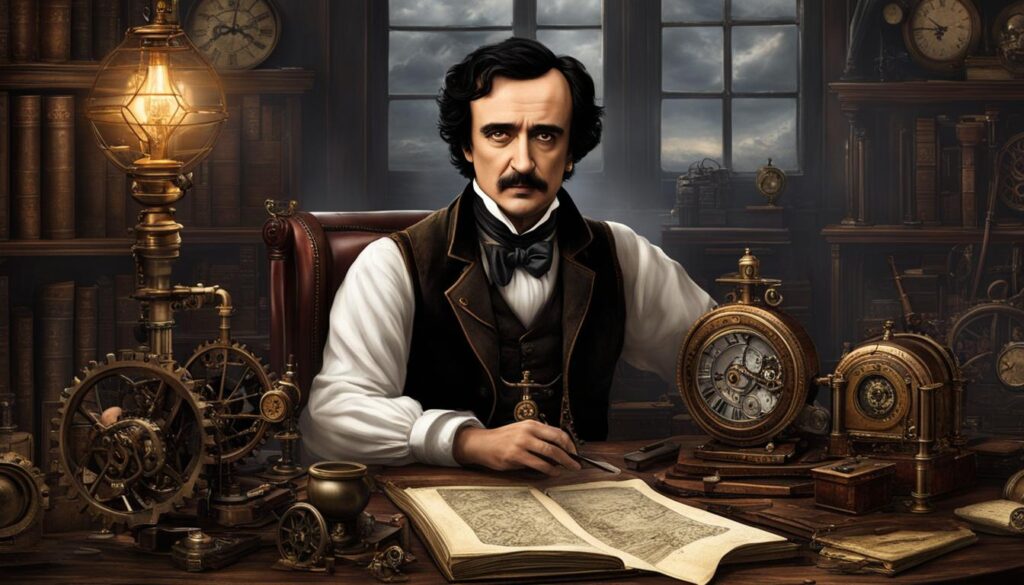
Edgar Allan Poe’s Legacy in Steampunk
Edgar Allan Poe’s influence on steampunk extends beyond his own works. His approach to storytelling, filled with intricate details, psychological depth, and a sense of unease, has shaped the narrative style of many steampunk authors and creators. The mysterious and brooding atmosphere that permeates Poe’s stories can be seen in the dark alleys, smoky factories, and shadowy corners of the steampunk world.
Moreover, Poe’s exploration of the human psyche and the boundaries of science and morality has resonated with steampunk’s thematic exploration of technology, progress, and societal implications. His tales of madness, obsession, and the fragile nature of the human mind find their echo in steampunk narratives that delve into the consequences of unchecked scientific advancements and the ethical dilemmas posed by technological innovations.
In conclusion, Edgar Allan Poe’s contribution to the steampunk genre cannot be ignored. Through his dark and haunting tales, he has become a pioneer of gothic fiction within the steampunk realm. His themes, characters, and atmosphere continue to inspire steampunk authors and artists, adding depth and complexity to the genre and ensuring that Poe’s legacy lives on in the world of retrofuturistic wonder.
William Morris – The Arts and Crafts Movement Meets Steampunk
William Morris, a renowned figure in the British Arts and Crafts movement, has left a lasting influence on the world of steampunk. His principles of craftsmanship, handcrafted objects, and rejection of industrialization align seamlessly with the essence of steampunk. While primarily known as a textile designer, Morris’s impact extends beyond his artistic contributions. His fantasy novels, such as “The Wood Beyond the World” and “The Well at the World’s End,” have also played a significant role in shaping the steampunk genre.
| Table: William Morris’s Influence on Steampunk | |
|---|---|
| 1. Aesthetics | Steampunk draws heavily from the visual appeal of Morris’s intricate and nature-inspired designs. The use of ornate patterns, rich colors, and attention to detail mirror the artistry found in Morris’s works. |
| 2. Handcrafted Elements | In both the Arts and Crafts movement and steampunk, there is a shared appreciation for handcrafted objects. The focus on manual labor, craftsmanship, and the rejection of mass production resonates strongly with the steampunk philosophy. |
| 3. Anti-Industrialization | Morris’s rejection of industrialization and his belief in the value of human labor echo the steampunk ethos. Steampunk often explores alternative histories where steam-powered technology prevails over mass production, reflecting Morris’s ideals. |
“The principles of the Arts and Crafts movement and steampunk are deeply intertwined. Both celebrate the beauty of handmade objects and reject the impersonal nature of modern industrialization. Morris’s influence on the steampunk genre is evident in its visual aesthetic, its focus on mechanical craftsmanship, and its exploration of alternative histories where Victorian-era technology thrives.”
Steampunk’s connection to the Arts and Crafts movement goes beyond visual aesthetics. It embodies the spirit of embracing traditional methods, valuing human labor, and cherishing the intrinsic beauty of handcrafted creations. Through the influence of William Morris, steampunk has become a genre that not only captivates the imagination but also reflects the timeless principles of craftsmanship and creativity.
The Influence of Morris’s Novels
Aside from his visual designs, Morris’s fantasy novels have also had a profound impact on the steampunk genre. Set in imaginative worlds filled with adventure and exploration, his stories resonate with the spirit of steampunk’s alternate histories and fantastical settings. The themes of Morris’s novels, such as the juxtaposition of civilization and the natural world, the quest for knowledge, and the pursuit of utopia, resonate strongly within steampunk narratives.
- The Wood Beyond the World: This novel, set in a parallel universe, inspired the concept of venturing into unknown realms and encountering fantastical creatures. The exploration of uncharted territories and the quest for a hidden paradise have become recurring motifs in steampunk literature.
- The Well at the World’s End: In this epic tale, Morris delves into the themes of time travel, destiny, and the human desire for immortality. Steampunk often explores similar concepts through the lens of Victorian-era science and technology, intertwining the fantastical with the mechanical.
William Morris’s visionary contributions to the Arts and Crafts movement have undeniably left their mark on the steampunk genre. From his intricate designs to his thought-provoking novels, his influence can be seen in the vibrant and imaginative steampunk worlds that continue to captivate readers and enthusiasts alike.
Conclusion
Steampunk has revolutionized the representation of historical figures, giving them a fresh, alternative perspective. Through the lens of steampunk, these iconic personalities become symbols of resistance, adventure, and social change. Their stories are reimagined in fantastical settings, blending history, technology, and imagination to create a vibrant and diverse steampunk world.
From Frederick Douglass to Mary Shelley, historical figures in steampunk literature, art, and media captivate audiences with their steampunk twists. Douglass, a voice for freedom, fights for equality in a steampunk world, while Shelley, the mother of steampunk literature, has her iconic Frankenstein reimagined with steampunk modifications. These figures not only enrich the steampunk genre but also shed light on the impact they have had on society.
By exploring the lives of these historical figures in a steampunk context, steampunk enthusiasts gain a deeper understanding of the past while embracing the innovative and imaginative possibilities of the future. Steampunk continues to push boundaries, merging the past with the present and allowing historical figures to transcend time, inspiring new generations to question, challenge, and envision a world where history and imagination collide.
FAQ
What is steampunk?
Steampunk is a subgenre of science fiction that combines retrofuturistic technology and aesthetics inspired by the 19th-century Victorian era.
Which historical figures are commonly represented in steampunk?
Historical figures such as Frederick Douglass, David Kalākaua, Sitting Bull, Mary Shelley, Edgar Allan Poe, and William Morris are often represented in steampunk literature, art, and media.
How is Frederick Douglass portrayed in steampunk?
Frederick Douglass is often portrayed as a heroic character fighting for freedom and equality, embodying steampunk’s themes of resistance and social change.
What is David Kalākaua’s role in steampunk?
In steampunk, David Kalākaua, the last king of the Kingdom of Hawaii, is often depicted as an adventurer, combining Hawaiian culture with steampunk aesthetics.
How is Sitting Bull represented in steampunk?
Sitting Bull, a Hunkpapa Lakota leader, is seen as an integral part of Native American resistance against U.S. government policies in steampunk, often portrayed as a symbol of strength and defiance.
What is Mary Shelley’s impact on steampunk?
Mary Shelley, known as the author of “Frankenstein,” is considered a pioneering figure in steampunk literature. Her creation of Victor Frankenstein and the mad scientist archetype has had a lasting impact on the genre.
How does Edgar Allan Poe fit into steampunk?
Edgar Allan Poe, known for his eerie and atmospheric tales, is regarded as a central figure of Romanticism and a pioneer of gothic fiction. His works have served as inspiration for blending mystery, science fiction, and horror in steampunk.
What is William Morris’s connection to steampunk?
William Morris, a leading figure in the British Arts and Crafts movement, has had a significant impact on steampunk aesthetics. His principles of handcrafted objects and rejection of industrialization align well with steampunk’s focus on mechanical craftsmanship.
How are historical figures represented in steampunk?
Historical figures in steampunk are often reimagined and given a steampunk twist, showcasing their bravery, impact on society, and exploring themes of science, technology, and social change.

